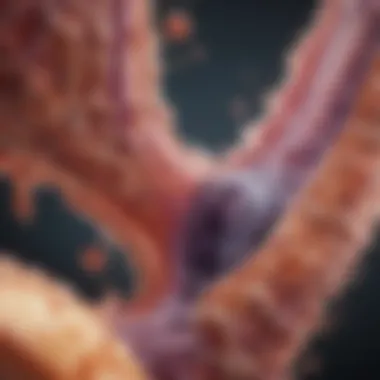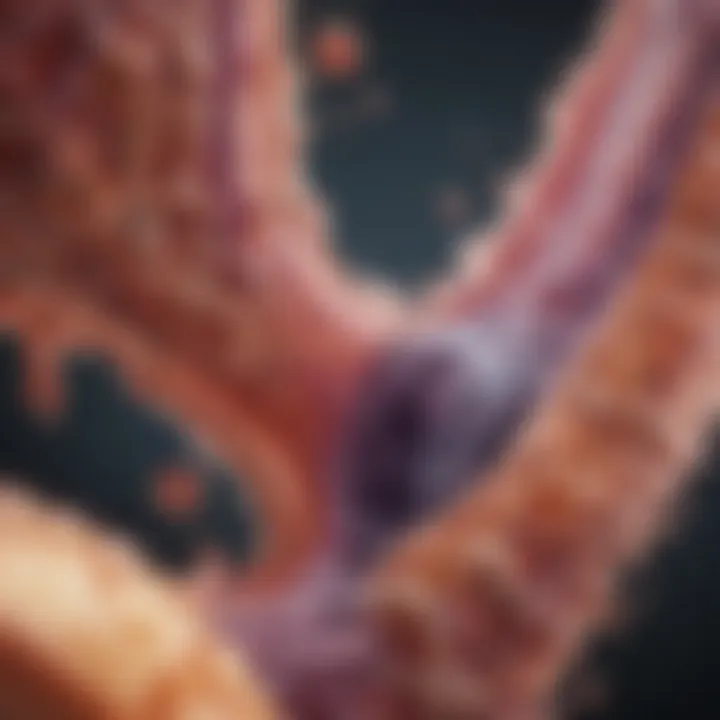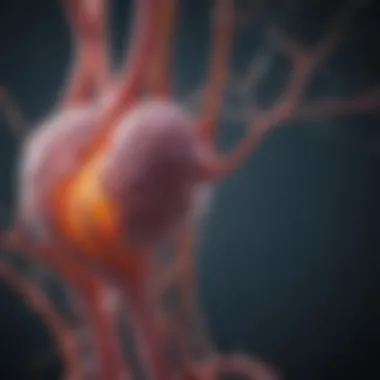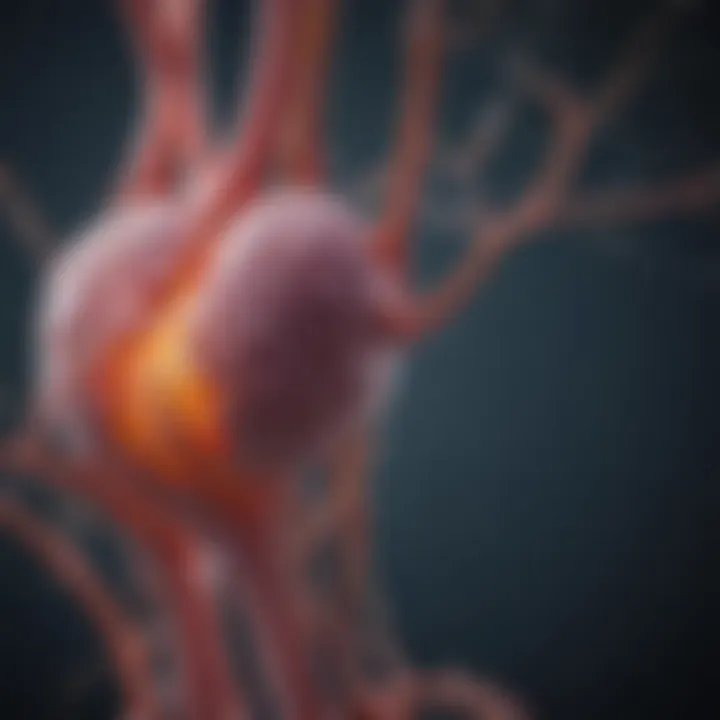Understanding Joint Pain Proteins: Mechanisms and Implications


Intro
Joint pain is a common condition that affects millions of people worldwide. The complexity of joint pain involves various factors, including inflammation, injury, and biochemical processes associated with specific proteins. This article aims to dissect these proteins, exploring their mechanisms and implications in musculoskeletal health.
Understanding how joint pain proteins function can provide crucial insights into pain management and potential therapeutic approaches. The article will delve into recent advancements in the field, highlight key methodologies in research, and discuss future directions in the study of joint pain proteins.
Recent Advances
Latest Discoveries
Recent research has shed light on specific proteins involved in pain signaling and modulation. For instance, nerve growth factor (NGF) has been identified as a significant player in the pathophysiology of osteoarthritis and rheumatoid arthritis. Its role in promoting neuronal sensitivity to pain has made it a target for new treatment strategies.
Other proteins, such as matrix metalloproteinases (MMPs), have been shown to contribute to tissue remodeling and inflammation in painful joints. Understanding the dynamics of these proteins is crucial for developing effective interventions that can alleviate joint pain.
Technological Innovations
Innovative technologies have revolutionized the way scientists study joint pain proteins. Techniques such as mass spectrometry and advanced imaging have enabled researchers to unravel the complex interactions between proteins in joint tissues.
These technologies provide insights into the protein composition of synovial fluid and cartilage, which can inform the design of drugs that target specific biochemical pathways involved in joint pain.
Methodology
Research Design
Studies on joint pain proteins typically employ a multidisciplinary approach that incorporates biochemistry, molecular biology, and clinical research. Researchers often use animal models to explore the pathological roles of specific proteins in joint disorders. Controlled clinical trials may also be implemented to evaluate the efficacy of new treatments targeting these proteins.
Data Collection Techniques
Data collection methods range from laboratory assays measuring protein concentration to patient-reported outcomes assessing pain levels. Techniques like immunohistochemistry not only identify protein expression levels in tissue samples but also provide valuable context for the correlation between protein presence and patient symptoms.
In summary, the exploration of joint pain proteins offers significant implications for understanding pain pathways and advancing treatment methodologies. Future research will likely continue to build on these findings, enhancing therapeutic strategies and improving patient outcomes.
Foreword to Joint Pain Proteins
Joint pain proteins represent a critical area of study in musculoskeletal health. Understanding these proteins can lead to greater insights into the causes and treatments of joint pain. Joint pain can arise from various conditions, including arthritis, injuries, and degenerative diseases. Thus, a comprehensive understanding of the proteins involved in pain mechanisms can guide therapeutic strategies and improve patient outcomes.
Definition of Joint Pain Proteins
Joint pain proteins are biological molecules that play significant roles in the pathways that cause and modulate pain in the joints. These proteins include pro-inflammatory cytokines, neuropeptides, and matrix metalloproteinases. They are involved in signaling processes that either promote pain sensation or contribute to inflammation and tissue breakdown. The specific functions and interactions of these proteins can vary, but their collective involvement in pain mechanisms is deeply significant.
Importance of Understanding Joint Pain Mechanisms
Recognizing the mechanisms underlying joint pain is essential for developing effective treatments. If researchers can pinpoint how specific proteins interact in pain pathways, targeted interventions may emerge. Furthermore, comprehending these mechanisms can also illuminate preventative measures. This understanding could lead to innovative approaches that enhance joint health.
Incorporating knowledge about joint pain proteins into clinical practice can improve management techniques. Clinicians can better tailor treatment plans based on the biochemical nature of pain in their patients.
Understanding joint pain mechanisms may transform pain management, enabling precision medicine tailored to individual needs and conditions.
In summary, delving into the intricacies of joint pain proteins is paramount not only for academic inquiry but for practical applications in healthcare. These insights provide a foundation for future research and therapeutic advancements that can significantly benefit individuals suffering from joint-related issues.
The Biochemical Nature of Joint Pain Proteins
Understanding the biochemical nature of joint pain proteins is fundamental for grasping the complex interactions that lead to musculoskeletal pain. These proteins, integral to various physiological processes, are involved in both normal and pathological conditions. Their mechanisms provide insights into pain management strategies and potential therapeutic interventions. By dissecting the types of proteins and their structural functions, we highlight the crucial role they play in pain pathways, ultimately influencing treatment approaches and patient outcomes.
Types of Proteins Involved in Pain Pathways


Pro-inflammatory cytokines
Pro-inflammatory cytokines are key players in the inflammatory response associated with joint pain. They facilitate communication between cells, promoting the recruitment of immune cells to sites of damage and inflammation. These proteins, such as interleukin-1 and tumor necrosis factor-alpha, amplify the pain experience by sensitizing nociceptors, the receptors that transmit pain signals. Their key characteristic lies in their ability to regulate inflammation and modulate pain mechanisms, making them a focal point of interest in this article.
A unique feature of pro-inflammatory cytokines is their dual role: while they serve to protect tissues from further injury, their excess can exacerbate pain and contribute to chronic conditions. Therefore, understanding their balance is critical in developing targeted approaches in pain management.
Matrix metalloproteinases
Matrix metalloproteinases (MMPs) are another group of proteins that significantly influence joint pain. Their primary function is to degrade extracellular matrix components, which is essential for tissue remodeling. In pathological conditions like osteoarthritis, MMPs can lead to the breakdown of cartilage, thus directly contributing to joint degeneration and pain. The key characteristic of MMPs is their enzymatic activity, which mediates both physiological and pathological tissue turnover.
MMPs' unique feature is their regulation by tissue inhibitors, which can be considered a double-edged sword. On one hand, they are vital for healing processes, but on the other, they can cause detrimental effects when unregulated, leading to increased pain and reduced mobility.
Neuropeptides
Neuropeptides serve as signaling molecules in the nervous system and play a relevant role in pain perception. Examples such as substance P and calcitonin gene-related peptide (CGRP) are critically involved in transmitting pain signals from peripheral sites to the central nervous system. Their key characteristic lies in their function as pain modulators, influencing both the amplification and attenuation of pain sensations. This makes them a beneficial focus in the context of joint pain research.
The unique feature of neuropeptides is their ability to interact with multiple receptors, leading to various physiological responses. This complexity can present both advantages, such as providing pathways for analgesic targets, and disadvantages, as their dysregulation may result in heightened pain sensitivity.
Protein Structure and Function
Protein folding and stability
The folding and stability of proteins are crucial to their function, particularly concerning joint pain proteins. Proper protein folding determines the active conformation necessary for function. Misfolded proteins can lead to functional loss and aggregation, contributing to joint pathologies. The key characteristic of protein folding is its role in determining specificity and activity, which is vital for the accurate response to pain stimuli.
This unique feature of folding underscores the importance of chaperone proteins, which assist in the correct conformation. Stability can be influenced by various factors like pH and temperature. Hence, understanding these dynamics is important for therapeutic development.
Active sites and binding mechanisms
Active sites of proteins are where biochemical reactions occur. The interactions of joint pain proteins at these sites are essential for signal transduction in pain pathways. The key characteristic of active sites is their specificity, allowing only certain molecules to engage and elicit responses. This selectivity is fundamental in drug design, as targeting these sites can enhance therapeutic efficacy.
Furthermore, the unique feature is how binding mechanisms dictate protein behavior and physiological responses. An improper interaction at an active site may impair protein function, potentially worsening pain conditions. Thus, exploring these areas may yield significant insights into new treatment strategies.
Mechanisms of Joint Pain Transmission
Understanding the mechanisms of joint pain transmission is crucial for the development of more effective pain management strategies. These mechanisms reveal the complex interplay between biochemical processes, structural changes in tissues, and the nervous system's role in signaling pain. Grasping these elements helps in identifying specific pain pathways, paving the way for targeted therapies that can alleviate discomfort and promote better joint health.
Etiology of Joint Pain
The etiology of joint pain encompasses various biological and physiological processes that lead to discomfort and impairment. Two significant aspects contribute to this: inflammatory responses and degenerative processes.
Inflammatory responses
Inflammatory responses are key players in the onset of joint pain. They involve a cascade of biochemical reactions initiated by injury or infection, leading to the release of pro-inflammatory cytokines and other mediators. A key characteristic of inflammatory responses is their ability to enhance pain sensitivity, often causing conditions like arthritis to manifest. This aspect is both beneficial and crucial for understanding the body’s defense mechanisms.
However, while inflammatory processes can lead to healing, they may also result in chronic pain if the inflammation persists. This highlights an important unique feature: inflammatory responses can become maladaptive.
Advantages of focusing on inflammatory responses include the potential for new treatment pathways. However, a disadvantage is that over-targeting inflammation can interfere with the body's natural healing response, leading to further complications in joint health.
Degenerative processes
Degenerative processes play a significant role in joint pain, particularly in conditions such as osteoarthritis. This aspect involves the gradual breakdown of cartilage and changes in the surrounding joint structures. A defining characteristic of degenerative processes is their chronic nature, often leading to cumulative joint damage over time. They are vital for understanding the long-term implications of joint pain.
The unique feature of degenerative processes is their ability to create a feedback loop of pain and disability. As joints degenerate, they often lead to increased pain, which can subsequently cause decreased mobility and further degeneration. This cycle is critical to identify to implement effective therapeutic strategies.
The advantages of exploring degenerative processes lie in developing preventive measures. However, a disadvantage is that once degeneration sets in, treatment becomes more complex and less effective, emphasizing the need for early intervention.
Role of Pain Receptors


Pain receptors, or nociceptors, are specialized nerve endings responsible for sensing pain stimuli. They are central to understanding how joint pain is perceived by the brain. The classification of different types of nociceptors and their functionalities enrich our comprehension of pain pathways.
Types of nociceptors
Types of nociceptors can be categorized based on their response characteristics. A key characteristic is their sensitivity to specific types of stimuli such as mechanical, thermal, and chemical signals. This categorization is beneficial for researchers and clinicians seeking to understand pain on a more granular level.
The unique feature here is that different nociceptors are activated by distinct stimuli, allowing for a tailored response in pain management. However, this complexity can also be a disadvantage as the interplay of different types complicates treatment plans.
Signal transduction processes
Signal transduction processes are fundamental for understanding how pain signals are relayed from nociceptors to the central nervous system. This involves a series of biochemical reactions that translate harmful stimuli into electrical impulses. A critical characteristic of signal transduction is its role in amplifying pain signals, which can lead to heightened pain perception or hyperalgesia.
Focusing on signal transduction processes provides insight into potential therapeutic targets. However, the disadvantage is that interventions aimed at blocking specific pathways may inadvertently disrupt normal pain signaling, leading to complications.
Understanding these mechanisms is essential for advancing treatments aimed at joint pain and enhancing overall musculoskeletal health.
The Impact of Joint Pain Proteins on Health
The impact of joint pain proteins on health is paramount. These proteins play a crucial role in various physiological processes that influence both mobility and overall quality of life. Understanding their effects allows for better insights into the management of joint pain and development of therapeutic interventions. This section examines how these proteins affect joint mobility and the broader implications on daily living experiences for those suffering from musculoskeletal disorders.
Effects on Joint Mobility
Joint mobility is significantly affected by the presence and activity of joint pain proteins. Proteins such as pro-inflammatory cytokines can lead to increased inflammation, which in turn can hinder movement. The relationship between inflammation and mobility is complex. When inflammation is present, it can cause swelling and stiffness in joints, reducing the range of motion. This can lead to a cycle where limited mobility results in further joint damage, increasing pain and discomfort.
Key Point: Understanding the changes in joint mobility due to pain proteins is essential for developing effective treatment options.
Additionally, the role of matrix metalloproteinases is notable. These enzymes break down extracellular matrix components, which can weaken joint structures. The degradation caused by matrix metalloproteinases may lead to conditions such as osteoarthritis. Experiencing pain during movement pushes individuals towards a sedentary lifestyle. Thus, the effects of joint pain proteins are not only about immediate pain but also the long-term implications for physical activity and health.
Influence on Quality of Life
The influence of joint pain proteins on quality of life is multidimensional. It encompasses both psychological considerations and physical limitations caused by joint pain conditions.
Psychological considerations
Psychological aspects of joint pain are crucial for understanding the full impact on quality of life. Chronic pain often leads to anxiety and depression, which can exacerbate the perception of pain. This interplay between pain and psychological well-being is significant. Knowing that the emotional state can affect pain levels is beneficial for treatment approaches. A holistic view of patient care must include mental health support alongside physical management strategies. This aspect lends itself to developing comprehensive care plans that address both psychological and physical health.
Physical limitations
Physical limitations arising from joint pain can be both drastic and debilitating. Individuals may find simple tasks, such as walking or standing for extended periods, to be challenging. Such limitations can lead to further complications, including decreased muscle strength and cardiovascular health. Understanding how joint pain proteins contribute to these limitations helps target interventions more effectively. For some, understanding these limitations may lead to proactive measures in therapy or lifestyle changes. Addressing physical limitations is essential for restoring functional independence, which is a primary goal in joint pain management.
In summary, joint pain proteins significantly influence health in terms of joint mobility and overall quality of life. Understanding these impacts can lead to better patient outcomes and revolutionary pain management strategies.
Research Advances in Joint Pain Protein Studies
Research into joint pain proteins has gained significant traction in recent years. This is largely due to an increased understanding of the biochemical pathways that govern pain transmission and inflammation in the body. Scientists are consistently working on elucidating the roles that various proteins play in these processes. This section will highlight the importance of current trends and innovations within this field.
Current Research Trends
In contemporary research, there is a marked focus on molecular pathways associated with joint pain. Many studies center on the following key areas:
- Identification of Novel Biomarkers: Researchers are searching for proteins that can serve as reliable biomarkers for joint pain. Understanding these proteins can lead to earlier diagnoses and more targeted therapies.
- Role of Genetics: The influence of genetic predisposition on the development of joint pain proteins is another active field. Understanding how genetic variations affect protein function may identify new treatment avenues.
- In vitro and in vivo Models: Improved modeling techniques are allowing a more profound exploration of how joint pain proteins interact within biological systems. These models help test potential therapeutic responses reliably.
Overall, these research trends are paving the way for deeper insights into the mechanisms of joint pain, which could ultimately lead to more effective treatment options.
Innovations in Pain Management


As the research progresses, innovations in pain management derived from these studies are being considered. Notable approaches include biologic therapies and targeted drug delivery systems.
Biologic therapies
Biologic therapies are revolutionizing the treatment landscape for joint pain. They are derived from living organisms and specifically target the pathways that are fundamental to pain and inflammation. The key characteristic of these therapies lies in their precision; they address specific proteins involved in the inflammatory processes instead of broadly suppressing the immune response.
This targeted approach makes biologic therapies a beneficial choice, as they can minimize side effects often seen with conventional treatments. One notable feature of biologic therapies is their ability to modulate immune responses without completely suppressing it, allowing for a more balanced approach to managing joint pain. However, biologic therapies can be expensive, which may limit access for some patients.
Targeted drug delivery
Targeted drug delivery systems represent another noteworthy innovation. These systems can deliver therapeutics directly to the site of pain, enhancing efficacy while reducing systemic side effects. The primary characteristic of targeted drug delivery is its ability to concentrate treatment where it is needed most, thereby maximizing the effect of the administration.
Such systems are considered beneficial because they can substantially improve therapeutic outcomes. A unique aspect of targeted drug delivery is the usage of nanoparticles, which can be engineered to release drugs in response to specific physiological triggers. This feature can enhance the precision of the therapy, but may also pose challenges related to development and regulatory approval.
"Innovations in biologic therapies and targeted drug delivery can significantly enhance pain management outcomes for patients suffering from joint pain."
In summary, the advances in research regarding joint pain proteins underline a significant leap in our understanding and management of joint pain. Both current research trends and innovations in pain management are crucial as they steer the future of treatment strategies in musculoskeletal health.
Future Directions in Joint Pain Protein Research
The exploration of joint pain proteins is an ongoing journey, with numerous opportunities for advancements. Addressing joint pain effectively requires a keen focus on developing therapeutic targets and adopting interdisciplinary methods. Understanding these proteins helps in creating innovative solutions for pain management and treatment. This section articulates the vital aspects that will shape future research in joint pain proteins, underscoring the importance of targeted approaches and collaborations across fields.
Potential Therapeutic Targets
Identifying potential therapeutic targets is crucial for advancing treatments for joint pain. Proteins involved in the pathways of pain can serve as focal points for developing new drugs. For instance, targeting specific pro-inflammatory cytokines or matrix metalloproteinases can mitigate the inflammatory process that contributes to pain. Successful modulation of these proteins can lead to improved joint function and reduced discomfort.
Research must prioritize protein-targeted therapies that are safer and more effective. This involves understanding protein interactions in detail, integrating findings from genetics, biochemistry, and clinical studies. The identification of specific pathways linked to joint pain allows researchers to create more personalized treatment approaches, enhancing patient outcomes.
Interdisciplinary Approaches
Collaborations between biology and medicine
Collaborative efforts between biology and medicine can significantly enhance the understanding of joint pain mechanisms. By combining basic research with clinical insights, scientists and medical professionals can develop comprehensive strategies for managing joint pain. This multidisciplinary endeavor enables a broader interpretation of data and facilitates the translation of research findings into everyday medical practices.
The key characteristic of such collaborations lies in their integration of diverse expertise. Biologists can provide insights into molecular mechanisms, while clinicians can offer practical perspectives on patient care. Thus, these partnerships are not only beneficial but essential for advancing joint pain research. Interdisciplinary approaches allow for innovative ideas and shared resources, leading to breakthroughs in treatment options.
Role of technology in protein analysis
Technology plays an indispensable role in the analysis of proteins related to joint pain. Advanced techniques in proteomics and bioinformatics enable researchers to analyze protein interactions and functions more comprehensively. This technological advancement is crucial for identifying novel biomarkers for joint pain and designing targeted therapies.
A key feature of technology in protein analysis is its capacity to handle large datasets, providing insights that were previously unattainable. This breadth of data analysis contributes to more profound understandings of the dynamic nature of pain mechanisms. While technological methods provide numerous advantages, researchers must also navigate challenges such as data interpretation and validation.
Ultimately, leveraging technology can accelerate progress in identifying effective therapeutic targets and formulating strategies to mitigate joint pain.
"The integration of diverse fields is not merely beneficial; it is critical to developing nuanced treatments for complex conditions such as joint pain."
In summary, the future direction of research on joint pain proteins embraces multiple avenues, focusing on collaborative efforts and technological innovations to expand the understanding and management of joint pain.
Culmination
Understanding joint pain proteins is crucial in the broader context of musculoskeletal health. These proteins are not merely biochemical entities; they play pivotal roles in pain transmission and modulation. Grasping their mechanisms enables researchers and health professionals to formulate more effective treatments. The implications of joint pain proteins extend beyond immediate pain relief, influencing long-term outcomes in patient mobility and life quality.
Summary of Key Points
- Joint pain proteins are central to the biological processes involved in pain signaling.
- Different types of these proteins, such as pro-inflammatory cytokines and neuropeptides, contribute to the sensation of pain in various ways.
- The mechanisms of pain transmission involve complex interactions between proteins and receptors, emphasizing the need for targeted research.
- Understanding the impact of joint pain proteins can lead to advances in therapeutic approaches, including biologic therapies and innovative drug delivery systems.
- Interdisciplinary collaboration is essential for advancing knowledge in this area, fostering innovations in pain management.
Final Thoughts on Joint Pain Proteins
The ongoing research into joint pain proteins reveals significant potential for therapeutic advances. Each discovery brings us closer to comprehensive pain management strategies that go beyond symptomatic relief. The potential therapeutic targets identified could revolutionize treatment modalities, making them more efficient and patient-centered. As we delve deeper into the interactions of these proteins, a clearer understanding of their role in health and disease will emerge, ultimately benefiting individuals suffering from chronic pain conditions.
"As we continue to explore the complexities of joint pain proteins, the future of pain management looks increasingly promising."
In summary, a thorough comprehension of joint pain proteins is vital. It informs not only the clinical management of pain but also paves the way for future research and innovative treatment options.















